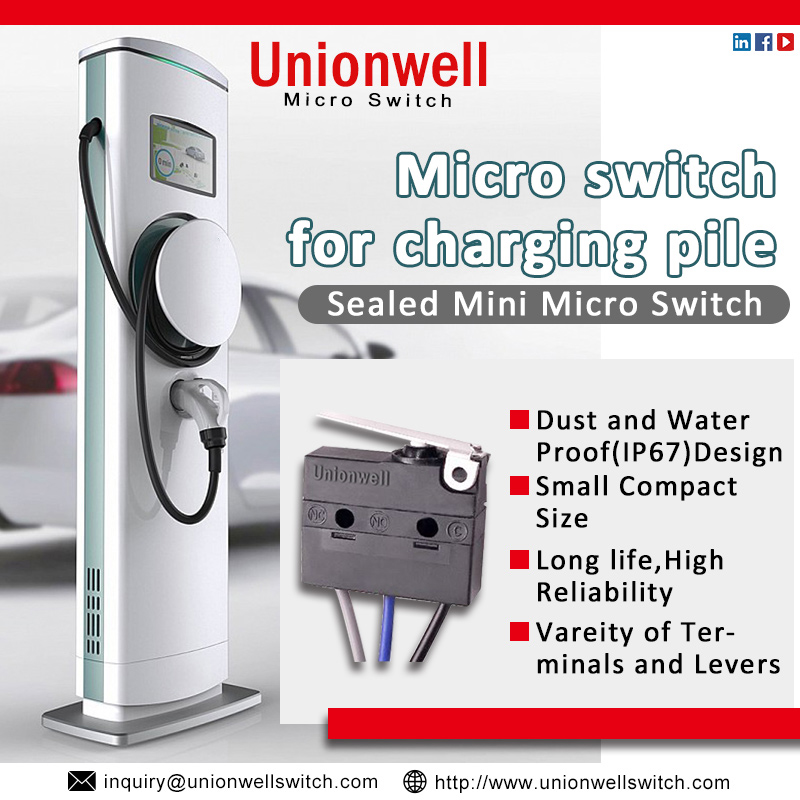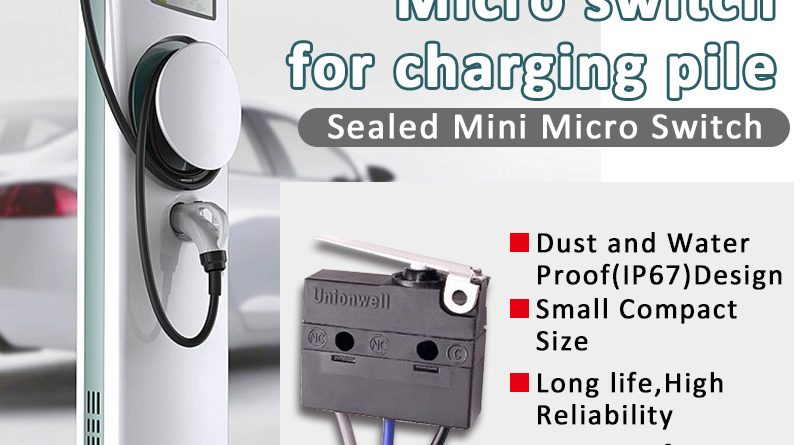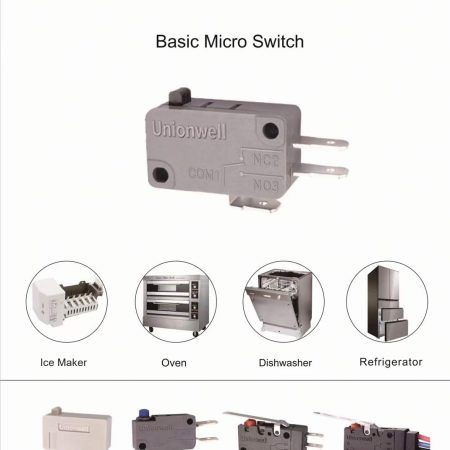Waterproof Micro Switch In Charging Pile

What is a charging pile?
The function of the charging pile is similar to the gas dispenser in a gas station. It can be fixed on the ground or wall and installed in public buildings (public buildings, shopping malls, public parking lots, etc.), residential quarters parking lots, or charging stations. It can use various waterproof sealed microswitch; it has levers and terminals to choose from; It can be based on different voltages. The level is for charging various types of electric vehicles.
The input end of the charging pile is directly connected to the AC grid, and the output end is equipped with a charging plug for charging electric vehicles. Charging piles generally provide two charging methods: conventional charging and fast charging. People can use a specific charging card to swipe the card on the human-computer interaction interface provided by the charging pile to perform operations such as the corresponding charging method, charging time, and cost data printing. The charging pile screen can display data such as charging capacity, cost, and time.
How do we classify the types of charging piles?
Installation method classify
According to the installation method, it can be divided into floor-mounted charging piles and wall-mounted charging piles. Floor-standing charging piles are suitable for installation in parking spaces that are not close to the wall. Wall-mounted charging piles are suitable for installation in parking spaces close to the wall.
Installation location classify
According to the installation location, it can be divided into public charging piles and particular charging piles. Public charging piles are built in public parking lots (garages) and parking spaces to provide public charging services for social vehicles. The unique charging pile is the self-owned parking lot (garage) of the construction unit (enterprise), which is used by the internal personnel of the unit (enterprise).
Self-use charging piles are built in personal parking spaces (garages) to provide charging for private users. Charging piles are generally combined with the construction of parking spaces in parking lots (garages). The protection level of charging piles installed outdoors should not be lower than IP54. The protection level of charging piles installed indoors should not be lower than IP32.
The number of charging ports classifies
According to the number of charging ports, it can be divided into one charger and one charger.
The charging method classify
According to the charging method, the charging pile (bolt) can be divided into DC charging pile (bolt), AC charging pile (bolt), and AC/DC integrated charging pile (bolt).
What is the basic principle of charging piles?
The charger consists of a rectifier that can convert the input AC power into DC power and a power converter to adjust the DC power. Insert the plug with the wire into the matching socket on the electric vehicle. Charge.
The charger is equipped with a locking lever to facilitate the insertion and removal of the plug, and the lever can also provide a signal to confirm that it has been locked to ensure safety. The power converter can adjust the DC charging power online according to the communication between the charger and the onboard battery management system. The charger can display the charging voltage, current, amount, and cost.
How to achieve all the functions of the charging pile technically?
AC
Technical requirements for AC charging piles (bolts)
1, Environmental requirements
- Working environment temperature: -20℃~+50℃;
- Relative humidity: 5%~95%;
- Altitude: ≤1000m;
- Installation location: outdoor;
- Earthquake resistance: the horizontal ground acceleration is 0.3g;
- The vertical ground acceleration is 0.15g;
- The equipment should be able to withstand three continuous sine waves acting simultaneously, and the safety factor should be greater than 1.67;
2, Structural requirements
- The shell of the AC charging pile (bolt) should be firm;
- The structure must prevent hands from quickly touching the exposed parts;
- The AC charging pile (bolt) should use a steel composite structure with a thickness of 1.0 or more, the surface should be treated with plastic dipping, and the designer should fully consider the requirements for heat dissipation. The charging pile (bolt) should have a good shielding function against electromagnetic interference;
- The charging pile (bolt) should have sufficient support strength, and the product designer should provide the necessary facilities to ensure the correct lifting, transportation, storage, and installation of equipment, and anchor bolt holes should be provided;
- People should fixedly install the bottom of the pile (bolt) body on a foundation not less than 200mm above the ground. The area of the base should not be greater than 500mm×500mm;
- The outer shell of the pile (bolt) body should be made of materials with strong impact resistance, good anti-theft performance, and anti-aging;
- The shell of non-insulating material should be grounded reliably;
3, Power requirements
- Input voltage: single-phase 220V;
- Output power: single-phase 220V/5KW;
- Frequency: 50Hz±2Hz;
- The allowable voltage fluctuation range is: single-phase 220V±15%;
4, Electrical requirements
- After the correct connection of the plug and the socket is confirmed, the load can be opened and closed before the circuit can be closed to realize the power supply to the socket;
- People should install the leakage protection device on the inlet side of the power supply cable;
- The protection of low-voltage power distribution equipment and lines should meet the relevant regulations of the industry;
- The insulation monitoring device should send audio or light signals to the IT system power distribution lines when the first ground fault occurs. When the second out-of-phase ground fault occurs, it should be protected by overcurrent protection appliances or leakage current actions. The device cuts off the faulty circuit;
- The same circuit should not power the lighting and socket circuits in the lighting power distribution system. The power supply side of the socket circuit should be equipped with a residual current action protection device with a rated operating current of 30mA; here, the unionwell waterproof microswitch plays a non-negligible role. A microswitch is used for automatic control and safety protection in equipment that requires frequent circuit switching. They are widely used in power systems, household appliances, electrical equipment, and other fields. Although the micro switches are small, they play an irreplaceable role.
5, safety protection function
- The AC charging pile (bolt) should be equipped with an emergency stop micro switch, which people can use for emergency stop of charging by manual or remote communication;
- The AC charging pile (bolt) should have the leakage protection function on the output side; The AC charging pile (bolt) should have over-current and short-circuit protection functions on the output side;
- The AC charging pile (bolt) should have a flame-retardant function;
6, IP protection level
- The AC charging pile (bolt) should be kept outdoors and equipped with necessary rain and sun protection devices;
7, three-proof (anti-moisture, anti-mildew, anti-salt fog) protection
- People should protect circuits against moisture, mildew, and salt sprays, such as the charger’s printed circuit boards and connectors. The salt spray corrosion resistance meets the industry’s requirements, so people use the charger outdoors in humid and salt spray environments. Normal operation;
8,Anti-rust (anti-oxidation) protection
- The iron casing of the charging pile (bolt) and the exposed iron supports and parts should take double-layer anti-rust measures. The non-ferrous metal casing should also have an anti-oxidation protective film or be treated with anti-oxidation;
9, wind protection
- The charger installed on the platform and the exposed parts should be able to withstand the relative wind speed in different areas and different heights specified by the industry;
10, anti-theft protection
- The shell door of the electric pile (bolt) should be equipped with an anti-theft lock, and the bolts for fixing the AC charging pile (bolt) must be installed or disassembled after the shell door is opened;
11, temperature rise requirements
- The AC charging pile (bolt) runs continuously for a long time under the rated load, and the temperature rise of the internal heating components and various parts should not exceed the industry regulations;
12, Mean time between failures (MTBF)
- MTBF should not be less than 8760h;
13, The vertical inclination of installation does not exceed 5%;
14, There must be no dangerous explosive medium in the installation site of the equipment, and the surrounding medium does not contain harmful gases and conductive medium that can corrode metals and damaged insulation
DC type
- a) Charging pile (bolt) power input voltage: three-phase four-wire 380VAC±15%, frequency 50Hz±5%;
- b) The charging pile (bolt) should meet the charging target
- c) The output of the charging pile (bolt) is direct current, and the output voltage meets the battery standard requirements of the charging object;
- d) The maximum output current meets the charging requirements of the standard battery 1C of the charging object and is backward compatible;
- e) The charging method is divided into two methods: conventional and fast; the conventional is the 5-hour charging method, and the fast is the 1-hour charging method (selected for different battery types);
- f) Realize innovative IC management;
- g) Each charging pile (bolt) has its operating device for users to select charging methods and operating instructions and display the battery status of the electric vehicle and the user’s IC card tariff information to realize management by itself;
- h) The charging pile (bolt) interface should comply with the relevant regulations of the DC charging interface in the electric vehicle conductive charging interface (temporary) in the industry;
- i) The communication interface of the charging pile (bolt) adopts the CAN communication interface, and the communication protocol is implemented by the provisions of the communication protocol (temporary) between the industry’s electric vehicle battery management system and off-board chargers (the charging object is lithium battery electric vehicles);
- j) The charging pile (bolt) shall have corresponding alarm and protection functions for abnormal conditions during the charging process;
- k) The charging pile (bolt) should monitor the battery status and automatically adjust according to the battery temperature, voltage versus charging curve, charging current, and charging voltage;
- l) The charging pile (bolt) adopts forced air cooling;
- m) The protection level of the charging pile (bolt) meets industry requirements;
All-in-one
Overview
Quick charging pile (bolt) equipment adopts an integrated AC and DC structure. Both DC is charging, and they can realize the AC charging. When there is a lot of charging business during the day, the DC method is used for fast charging, and when there are few users at the charging station at night, People can use the AC charging for slow charging.
Shape characteristics
- Ergonomic design, fully considering the characteristics of the Chinese. After installation, the height of the whole machine, the height of the screen, the height of the keyboard, and the height of the charging connector slot are suitable for operation;
2. the form of the upper outlet saves half of the operator’s physical strength;
- Considering people’s usage habits and durability, the touch screen and keyboard are mutually backed up, and the touch screen and keyboard are designed to be rain-proof and dust-proof;
- Equipped with an emergency stop switch for emergency shutdown; equipped with a charging connector placement slot, which is waterproof; 5 meters long flexible cable.
Features
- Provide man-machine interactive operation; provide DC and AC charging ports;
- With prompt voice function; with card swiping function;
- With the function of printing receipts;
- Real-time communication with BMS to obtain information such as power battery type, cell voltage, remaining capacity, temperature, alarm, etc.;
- Send control commands and switch signals to the charger, control the start and stop of the charger, and obtain the status information of the charger;
- Equipped with complete safety protection control logic such as the connection status judgment, interlocking, and control guidance of the charging interface;
- With CAN2.0B and RS485 communication interfaces, it can communicate with centralized monitoring and upload charging status information;
- With protection functions such as leakage, short circuit, over-voltage, under-voltage, over-current, etc., to ensure the safe and reliable operation of the charging pile (bolt), the protection level is IP54.
Safety requirements and precautions for charging piles
(1) The substation shall have safety fences, warning signs, safety signal lights, and alarm bells.
(2) A warning sign of “Stop, High Voltage Danger” should be hung outside the door of the high-voltage power distribution room and the transformer room or on the safety column of the substation. The warning signs must face the outside of the fence.
(3) There should be significant operating instructions on the high-voltage power distribution device. The user should mark the grounding point of the equipment.
(4) There should be obvious signs of “safe passage” or “safe exit” indoors.
In addition, the layout design of the substation and power distribution equipment should be convenient for installation, operation, transportation, maintenance, testing, and monitoring. High and low-voltage power distribution rooms, transformer rooms, capacitor rooms, and control rooms should not have pipes and lines that have nothing to do with them.
Why choose Unionwell micro switch in China?
Unionwell Micro Switch Manufacturer From China
Huizhou Unionwell Sensing & Control Electronics Co., Ltd specializes in producing quality micro switches for the automotive industry and white goods of home appliances. Main products include basic micro switches, waterproof switches, air pressure switches, mechanical keyboard switches, and door switches.
For better pricing, lead time, and quality control guarantees, we acquired Huizhou Greetech Electronics Co., Ltd in 2021. We made it our China production base with over 500 employees and a 250 million pieces/year production capacity.
With the subsidiary sales branch Guangzhou Unionwell Sensing & Control Technology Co., Ltd founded, our global reach covers North America, Europe, Asia, and South America.
Most of our business partners/end customers are Global 500 enterprises, including world-famous home appliance brands and leading automotive suppliers in North America and Europe.
We are launching a new industrial base at Longmen, Huizhou, Guangdong Province, which will work as Unionwell headquarters. Automation equipment will be introduced, massively improving the switch production capacity from 250 million pieces to over 1.3 billion pieces/year.
For more micro switches, please visit our website:
http://www.unionwellswitch.com
Send an email to get more information: inquiry@unionwellswitch.com
Related Articles:
How to Wire a Microswitch Tap and Water pump






